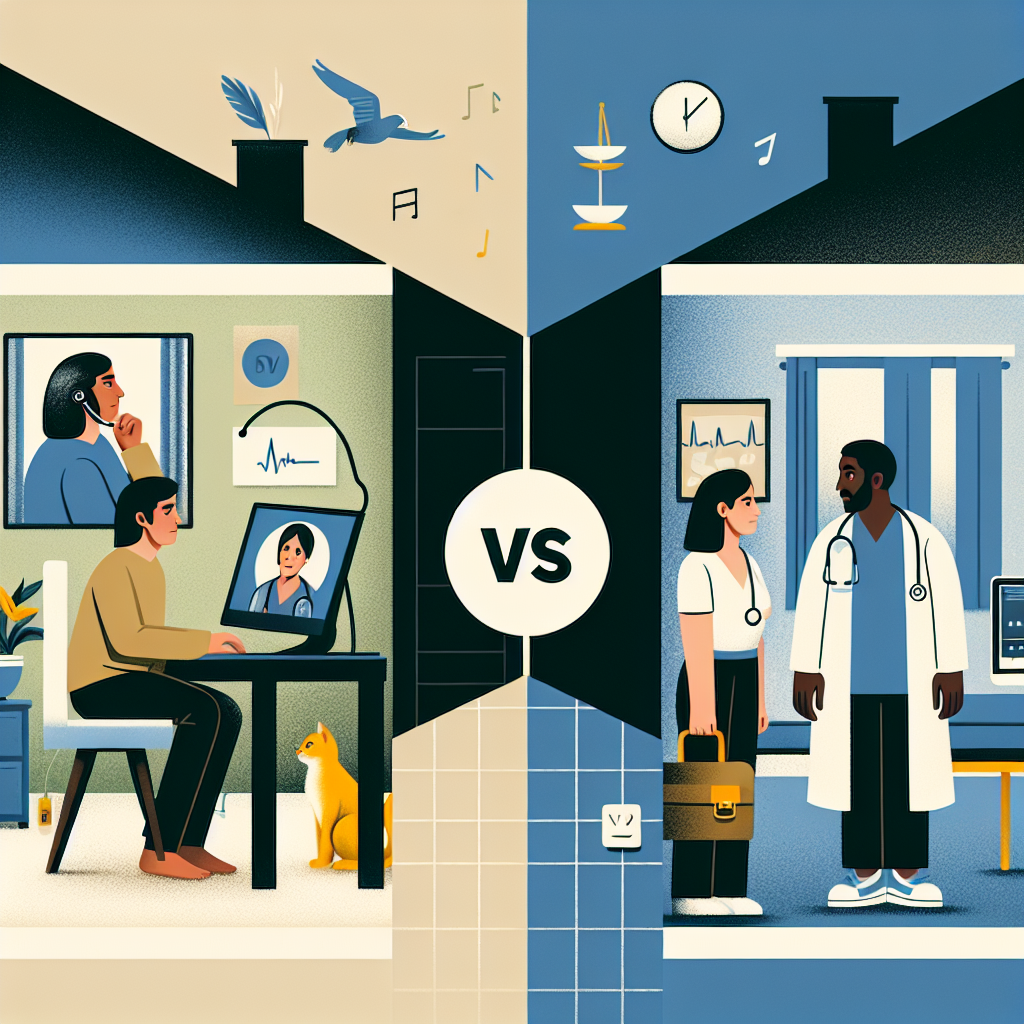
Introduction
In an era defined by technological advancement, the healthcare landscape is undergoing a significant transformation. The rise of telehealth is not just a trend; it has become a crucial component of modern medicine. As patients increasingly weigh the options of telehealth vs. in-person visits, understanding the pros and cons of each approach is essential. With the global pandemic prompting many to reconsider how they access healthcare, this article delves deeply into the nuances of both methods. By equipping readers with knowledge, we empower informed decisions about their health journeys.
The Rise of Telehealth
Telehealth, or the delivery of healthcare services remotely using digital technology, gained massive traction during the COVID-19 pandemic. What once seemed like a niche option has become an integral part of routine medical care. But is it the right solution for everyone?
Meanwhile, in-person visits have been the gold standard for patient care, ensuring face-to-face interaction and comprehensive physical examinations. Yet, as we navigate the complexities of healthcare today, it’s essential to understand the merits and drawbacks of telehealth vs. in-person visits.
Telehealth: Pros and Cons
Pros of Telehealth
-
Accessibility: One of the most significant advantages of telehealth is its ability to provide access to care for individuals in remote areas. Patients no longer need to travel long distances, saving time and reducing transportation barriers.
-
Convenience: Scheduling an appointment for telehealth is generally easier. Patients can consult with their healthcare providers from the comfort of their homes, fitting medical appointments into their busy lives.
-
Cost-Effectiveness: Often, telehealth services are less expensive than in-person visits. This is beneficial for both patients and healthcare providers who can allocate resources more efficiently.
-
Time-Saving: Telehealth eliminates the time spent waiting in a doctor’s office, allowing patients to speak with healthcare professionals promptly.
- Greater Continuity of Care: For patients managing chronic conditions, telehealth enables more regular check-ins without the hassle of travel, promoting better health outcomes.
Cons of Telehealth
-
Limited Physical Examination: One of the notable drawbacks of telehealth is the inability to perform thorough physical examinations. Some health issues require in-person assessments that can’t be replicated remotely.
-
Technology Barriers: Not everyone is tech-savvy, and some patients may find it challenging to use telehealth platforms. This can lead to feelings of frustration and disconnect.
-
Privacy Concerns: While telehealth platforms strive for security, there are always risks associated with sharing sensitive health information online. Patients may feel insecure about the confidentiality of their data.
-
Inability to Handle Emergencies: Telehealth is not suitable for emergency care. In urgent situations, in-person visits remain crucial.
- Reduced Personal Interaction: For many, the emotional connection with a healthcare provider is vital. Telehealth can sometimes feel impersonal and lack the warmth of face-to-face interactions.
Case Study: Health On-Line
Health On-Line, a telehealth platform, flourished during the pandemic. They reported a 200% increase in consultations as patients sought remote alternatives. Their system provides a variety of services ranging from mental health consultations to routine check-ups, illustrating telehealth’s versatility. However, users also reported the lack of physical examination as a pressing concern, highlighting the telehealth vs. in-person visits dilemma.
In-Person Visits: Pros and Cons
Pros of In-Person Visits
-
Comprehensive Assessments: In-person visits allow for thorough examinations and diagnostic testing, ensuring accurate diagnoses and treatment plans.
-
Human Connection: Face-to-face interactions foster a deeper emotional connection between healthcare providers and patients, often leading to better patient satisfaction.
-
Immediate Access to Care: In emergencies, in-person visits provide immediate assistance and necessary interventions that telehealth cannot offer.
-
Built-in Equipment: Healthcare facilities are equipped with the necessary tools to conduct a wide variety of tests and procedures that are simply unavailable at home.
- Insurance Coverage: Many insurance plans provide comprehensive coverage for in-person visits, which sometimes yields lower out-of-pocket expenses for patients.
Cons of In-Person Visits
-
Travel and Time Constraints: Patients must travel to and from the appointment, which can be a barrier, especially for those with mobility issues or living in remote areas.
-
Long Wait Times: Waiting for an appointment can be a frustrating experience, increasing the time between seeking healthcare and receiving treatment.
-
Higher Costs: In-person visits can be costly due to the overhead associated with operating medical facilities, potentially leading to higher bills for patients.
-
Inflexible Scheduling: Many patients find it challenging to fit scheduled medical appointments into their busy lives, making telehealth a more appealing option.
- Exposure to Illness: Visiting a healthcare facility can increase the risk of exposure to various pathogens, particularly for immunocompromised individuals.
Case Study: HealthFirst Clinic
HealthFirst Clinic experienced a surge in demand for in-person services as a direct response to their perceived reliability during the pandemic. Patients specifically cited the assurance of in-depth examinations as a key reason for their preference for in-person visits. Healthcare providers noted that certain conditions, such as acute infections, were best diagnosed through immediate physical assessment.
Comparing Effectiveness
To truly understand the landscape of telehealth vs. in-person visits, it’s important to consider scenarios in which each might excel.
Table: Effectiveness Comparison
| Factor | Telehealth | In-Person Visits |
|---|---|---|
| Access | High (rural areas, busy schedules) | Moderate (depends on location) |
| Convenience | Very High (home consultations) | Low (travel and waiting times) |
| Physical Examination | Limited (virtual assessments only) | Comprehensive |
| Emergency Care | Non-existent | Immediate access |
| Cost | Generally Lower | Generally Higher |
Conclusion
As we stand at the crossroads of healthcare innovation, understanding the intricate details of telehealth vs. in-person visits is vital. Each approach has its unique strengths and limitations, making it imperative for individuals to assess their personal healthcare needs.
Telehealth offers unprecedented accessibility and convenience for many, particularly for follow-up visits and routine consults. In contrast, in-person visits remain essential for critical assessments and emergencies.
In navigating the decision of which route to take, patients should consider their specific circumstances, health needs, and personal preferences. Ultimately, a hybrid approach that incorporates the best of both worlds may prove to be the most effective strategy.
FAQs
1. Is telehealth as effective as in-person visits?
Telehealth can be as effective for non-emergency consultations, though it may not provide the same depth of examination available in-person. Effectiveness can vary based on the health issue.
2. Do insurance plans cover telehealth?
Many insurance plans have expanded coverage for telehealth services, particularly after the pandemic. It’s essential to check specific policy details.
3. What technology is needed for telehealth?
Basic technology required includes a device with internet access, a camera, and a microphone. Most telehealth platforms are user-friendly.
4. Can I get emergency care through telehealth?
No, telehealth is not suitable for emergency situations. If you experience a medical emergency, seek immediate in-person assistance.
5. How do I prepare for a telehealth appointment?
Prepare by having relevant medical information on hand, ensuring your technology works, and choosing a quiet space for your consultation.
Takeaway
As the healthcare landscape continues to evolve, patients should feel empowered to make choices that align with their preferences and needs. Whether opting for telehealth or in-person visits, understand that both have unique merits—and your health choices matter.















